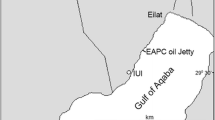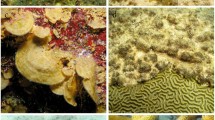Summary
In Panamá, vertical zonation of coral species is well marked; branching corals (Pocillopora spp.) predominate in shallow (1–6 m) water while massive forms (Pavona spp.) occupy the deeper (6–10 m) areas of the reef. To test the hypothesis that this zonation represents differential resource utilization (i.e., niche partitioning of food resources), one year manipulative field experiments were conducted at two depths (1 m and 7 m below Mean Lower Sea Level) assessing the relative contribution of light and zooplankton to the nutrition of three Pacific corals: Pocillopora damicornis, Pavona clavus and Pavona gigantea. Also tested were the related hypotheses that (i) energy for the maintenance and growth of corals comes mainly from light, independent of zooplankton supply and (ii) Porter's model, in which coral morphology is a predictor of the phototrophic-heterotrophic capabilities of a particular species. That is, corals with a branching morphology and a small polyp diameter (and short tentacle length) should be primarily phototrophic while those species with larger polyps and/or a massive form should show a greater degree of heterotrophy.
The comparison of caged versus control corals indicated that the branching coral, Pocillopora damicornis (polyp diameter — 1 mm) grew independent of zooplankton supply (>95μ) but was markedly affected by shading. Pavona clavus (massive form with intermediate size polyps — 2 mm) was also negatively affected by shading but this effect was minimized when zooplankton was present. Surprisingly, under ambient light conditions, the growth of this specics was independent of zooplankton (>95μ); perhaps indicating a facultative reliance on zooplankton especially in shallow water. The third species, Pavona gigan-tea (massive form with largest polyps — 3 mm) was highly dependent on both light and zooplankton and was unable to compensate for the effects of shading by zooplankton feeding. This high dependence on light was unexpected since large polyps, according to Porter's model, would predict a more heterotrophic existence.
Under all treatments, in both shallow and deep water, Pocillopora was found to grow more rapidly than either massive species. Thus, this study indicates that zonation on eastern Pacific reefs cannot be explained by depth-related differences in nutritional requirements among the species present. These results do provide the first long-term, experimental field evidence that corals are largely phototrophic organisms. The validity of Porter's model attempting to correlate phototrophic-heterotrophic abilities to morphological characteristics is, at least, partially verified: species with larger tentacles do appear to utilize zooplankton to a greater extent than those species with smaller tentacles. However, the significance of corallum morphology in predicting the mode of nutrient acquisition is unclear. Rather, behavioral patterns (tentacle expansion-contraction cycles) and location on the reef may be more important factors to consider.
Similar content being viewed by others
References
Alldredge AL, King JM (1977) Distribution, abundance, and substrate preferences of demersal reef zooplankton at Lizard Island, Great Barrier Reef. Mar Biol 41:317–333
Birkeland C, Meyer DL, Stames JP, Buford CL (1975) The subtidal communities of Malpelo, pages 55–68. In: JB Graham (ed) The biological investigation of Malpelo Island, Columbia. Smith Contri Zool 176:1–98
Boschma H (1926) On the food of reef-corals. Proceedings Academy of Sciences, Amsterdam 29:993–997
Buss LW (1979) Bryozoan overgrowth interactions — the interdependence of competition for space and food. Nature 281:475–477
Connell JH (1973) Population ecology of reef-building corals. In: OA Jones and R Endean (eds) Biology and geology of coral reefs. Biology 1, Vol 2, Academic Press, New York p 205–245
Connell JH (1978) Diversity in tropical rain forests and coral reefs. Science 199:1302–1310
Doty MS (1971) Measurements of water movement in reference to benthic algal growth. Botanica Marina 14:32–35
Doty MS, Oguri M (1965) The island mass effect. J du Cons Perm Int Explor Mer 22:33–37
Dustan P (1979) Distribution of zooxanthellae and photosynthetic chloroplast pigments of the reef-building coral Montastrea annularis Ellis and Solander in relation to depth on a West Indian coral reef. Bull Mar Sci 29:79–95
Fishelson L (1973) Ecological and biological phenomena influencing coral-species composition on reef tables at Eilat (Gulf of Aqaba, Red Sea). Mar Biol 19:183–196
Forsbergh ED (1969) On the climatology, oceanography and fisheries of the Panamá Bight. Bull Int-Amer Trop Tuna Comm 14:45–385
Franzisket L (1970) The atrophy of hermatypic reef corals maintained in darkness and their subsequent regeneration in light. Int Revue ges Hydro 55:1–12
Glynn PW (1972) Observations on the ecology of the Caribbean and Pacific coasts of Panamá. In: ML Jones (ed) The Panamá biota: some observations prior to a sea-level canal. Bull Biol Soc Wash 2:13–30
Glynn PW (1973) Ecology of a Caribbean coral reef. The Porites reef-flat biotope. Part III. Plankton community with evidence for depletion. Mar Biol 22:1–22
Glynn PW (1976) Some physical and biological determinants of coral community structure in the eastern Pacific. Ecol Monogr 46:431–456
Glynn PW (1977) Coral growth in upwelling and non-upwelling areas off the Pacific coast of Panamá. Jour Mar Res 35:567–585
Glynn PW, Stewart RH, McCosker JE (1972) Pacific coral reef of Panamá: Structure, distribution and predators. Sonder Geol Runds 61:483–519
Glynn PW, Stewart RH (1973) Distribution of coral reefs in the Pearl Islands (Gulf of Panamá) in relation to thermal conditions. Limnol and Oceanogr 18:367–379
Goreau TF, Goreau NI (1959) The physiology of skeleton formation in corals. II. Calcium deposition by hermatypic corals under various conditions in the reef. Biol Bull Mar Lab Woods Hole 117:239–250
Goreau TF, Goreau NI (1960) The physiology of skeleton formation in corals. III. Calcification rate as a function of colony weight and total nitrogen content in the reef-coral Manicina areolata (Linnaeus). Biol Bull 118:419–429
Hamner WM, Carleton JH (1979) Copepod swarms: attributes and role in coral reef ecosystems. Limnol Oceanogr 24:1–14
Houck JE (1978) The potential utilization of scleractinian corals in the study of marine environments. PhD Thesis, University of Hawaii, Honolulu, Hawaii
Johannes RE (1974) Sources of nutritional energy for reef corals. Pro Int Coral Reef Sym, 2nd, 1:133–137
Johannes RE, Coles SL, Kuenzel NT (1970) The role of zooplankton in the nutrition of some scleractinian corals. Limnol Oceanogr 15:579–586
Johannes RE, Tepley L (1974) Examination of feeding of the reef coral Porites lobata in-situ using time lapse photography. Pro Coral Reef Sym, 2nd, 1:127–131
Jokiel PL (1978) Effects of water motion on reef corals. J exp mar Biol Ecol 35:87–97
Kawaguti S (1937) On the physiology of reef coral II. The effect of light on color and form of reef corals. Palao Trop Biol Stat Stud 1:199–208
Kawaguti S (1965) An electron microscopic proof of a path of nutritive substances from zooxanthellae to the reef coral tissue. Pro Japan Acad Sci 40:832–835
Lamberts AE (1974) Measurements of Alizarin deposited by coral. Pro Int Coral Reef Sym, 2nd, 2:241–244
Lang JC (1973) Interspecific aggression by scleractinian coral. 2. Why the race is not only to the swift. Bull Mar Sci 23:260–279
Lewis DH, Smith DC (1971) The autotrophic nutrition of symbiotic marine coelenterates with special reference to hermatypic corals. I. Movement of photosynthetic products between the symbionts. Pro Royal Soc Lond Biol Sci 178:111–129
Loya Y (1976) Recolonization of Red Sea corals affected by natural catastrophes and man-made pertubations. Ecology 57:278–289
Muscatine L (1973) Nutrition of corals. In: OA Jones and R Endean (eds), Biology and geology of coral reefs. Biology 1, Vol 2, Academic Press, New York, p 77–115
Muscatine L, Cernichiari E (1969) Assimilation of photosynthetic products of zooxanthellae by a reef coral. Biol Bull 137:506–523
Muscatine L, Porter JM (1977) Reef corals: mutualistic symbioses adapted to nutrient-poor environments. Biosci 27:454–460
Muscatine L, D'Elia CF (1978) The uptake, retention, and release of ammonium by reef corals. Limnol and Oceanogr 23:725–734
Muus BJ (1968) A field method for measuring “exposure” by means of plaster balls. A preliminary account. Sarsia 34:61–68
Odum HT, Odum EP (1955) Trophic structure and productivity of a windward coral reef community on Eniwetok Atoll. Ecol Monogr 25:297–320
Porter JW (1974) Zooplankton feeding by the Caribbean reef-building coral Montastrea cavernosa. Pro Int Coral Reef Sym, 2nd, 1:111–125
Porter JW (1976) Autotrophy, heterotrophy and resource partitioning in Caribbean reef-building corals. Am Nat 10:731–742
Porter JW, Porter K, Batac-Catalan Z (1977) Quantitative sampling of Indo-Pacific demersal reef plankton. Pro Int Coral Reef Sym, 3rd, 1:105–112
SAS User's Guide 1979 Edition, Raleigh, North Carolina
Schoener TW (1974) Resource partitioning in ecological communities. Science 185:27–39
Sebens KP (1977) Autotrophic and heterotrophic nutrition of coral reef zoanthids. Pro Int Coral Reef Sym, 3rd, 1:397–405
Sebens KP, DeRiemer K (1977) Diel cycles of expansion and contraction in coral reef anthozoans. Mar Biol 43:247–256
Smith DC, Muscatine L, Lewis DH (1969) Carbohydrate movement from autotrophs to heterotrophs in parasitic and mutualistic symbiosis. Biol Rev 44:17–90
Sokal RR, Rohlf FJ (1969) Biometry. WH Freeman and Company, San Francisco
Sorokin YI (1973) On the feeding of some scleractinian corals with bacteria and dissolved organic matter. Limnol Oceanogr 18:380–385
Trench RK (1971) The physiology and biochemistry of zooxanthellae with marine coelenterates. I. The assimilation of photosynthetic products of zooxanthellae by two marine coelenterates. Pro Royal Soc (B) 177:225–235
Trench RK (1974) Nutritional potentials in Zoanthus sociatus (Coelenterata, Anthozoa). Helgol wiss Meeresunters 26:174–216
Wellington GM (1981) The role of competition, niche diversification and predation on the structure and organization of a fringing coral reef in the Gulf of Panamá. PhD Dissertation. University of California, Santa Barbara
Wethey DS, Porter JW (1976) Sun and shade differences in productivity of reef corals. Nature 262:281–282
Yonge CM, Nicholls AG (1931) Studies on the physiology of corals. V. The effect of starvation in light and darkness on the relationship between corals and zooxanthellae. Sci Rep Great Barrier Reef Exped 1:177–211
Author information
Authors and Affiliations
Rights and permissions
About this article
Cite this article
Wellington, G.M. An experimental analysis of the effects of light and zooplankton on coral zonation. Oecologia 52, 311–320 (1982). https://doi.org/10.1007/BF00367953
Received:
Issue Date:
DOI: https://doi.org/10.1007/BF00367953




